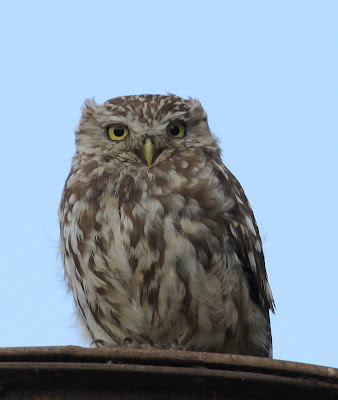A nine metre tide at 11am meant a three hour birding stint at Pilling, a session which produced a few more waders together with a noticeable south-easterly movement of Swallows.
Passerine numbers improved today, probably as result of the tide pushing the finches off the marsh where they often feed, 20+ Linnet, 30 Goldfinch and 4 Greenfinch. Still 2 Skylark, but a single Pied Wagtail and nil Meadow Pipits.
Gangs of Canada Geese are quite unusual at Lane Ends but 50+ today, and also a separate flock of 21 Greylag Geese, the latter having bred hereabouts, with the only other wildfowl of note being 22 Shelduck. Others, 3 Great Crested Grebe, 4 Cormorant and 3 Grey Heron.
Grey Heron
Yesterday I had an email from someone local who told me of a couple of yet-to-fledge but wildly flapping Grey Heron chicks in a Knott End nest. It seems inordinately late in the year as around here Grey Heron chicks are normally long gone from nests by May. Reading up BWP it seems that Grey Herons are normally single brooded but may replace a clutch of eggs if they or subsequent young are lost. Maybe the weird weather of May, June and July is a factor.
Waders on the wildfowler’s pools, 1 Green Sandpiper and 1 Common Sandpiper. Waders on the shore, 110 Curlew, 15 Redshank, 8 Oystercatcher, 22 Dunlin and 4 Grey Plover.
Dunlin
Grey Plover
A Peregrine put in a fleeting but star appearance when it chased a feral pigeon from off the marsh and almost over my head. It gave up the pursuit when spotting me just ahead of its trajectory, leaving me with the clatter of wings of the fleeing pigeon and sight of the peg heading back out to sit on the marsh.
The movement of Swallows was more or less constant, birds feeding low over the marsh or heading east along the sea wall before flying more distantly into the stiff south-easterly wind, an estimated 160 in three hours. Just 2 Swift today flying high and directly south.
More from Another Bird Blog tomorrow I hope.


















































.jpg)












